« Мой белый город – ты цветок из камня, омытый добрым солнечным дождем...» – пела когда-то София Ротару о Кишиневе. Эти слова в полной мере можно произнести в адрес многих португальских городов. Мне же хочется рассказать об Эворе – сердце португальской провинции Алентежу.
Разбросанные по холмам замки-крепости, небольшие средневековые городки с белыми домиками, окруженные виноградниками, плантациями оливковых деревьев и рощами пробковых дубов – все это Алентежу, самый крупный регион, расположенный в центре Португалии.
Эвора, самый большой и красивый город провинции, имеющий богатое культурное и историческое прошлое, был важным центром у римлян, мавров, становился резиденцией эпископов, а позднее – резиденцией португальских королей, был свидетелем многих королевских свадеб.
Здесь лабиринты узких средневековых улочек переплетаются с залитыми солнцем площадями, готическими порталами, мавританскими двориками, монастырями, соборами, дворцами… Исторический центр города включен в список Всемирного наследия ЮНЕСКО.
Многие столетия Эвора является духовным центром страны – на 41 тысячу горожан проходится почти 30 церквей и монастырей.
В один из дней нашего знакомства с Португалией мы отправились в Эвору на электричке с лиссабонского вокзала Entrecampos. Город встретил нас сухим жарким воздухом и традиционно украшенным изразцами – азулежу – привокзальным зданием.
 Эвора. Вокзал
Эвора. Вокзал
 Эвора. Вокзал
Эвора. Вокзал
Первое строение на пути от вокзала к центру Эворы, привлекшее наше внимание, похожее то ли на замок, то ли на крепость – часовня Сан-Брас (Ermida de Sã o Bras). Этот храм был возведен по инициативе короля Иоанна II и епископа Эворы Д. Гарсия де Менезес в 1483 году в стиле « готического варианта мануэлино-мудехар» . Как оказалось, стены, увенчанные зубцами и коническими башенками, типичны для Алентежу.
 Эвора. Часовня Сан-Брас
Эвора. Часовня Сан-Брас
 Эвора. Часовня Сан-Брас
Эвора. Часовня Сан-Брас
Когда мы подошли ко входу в часовню, проходила утренняя служба, и несколько человек стояли на улице – зал внутри небольшой. Но как только я взяла в руки фотоаппарат, – люди вежливо расступились, позволив сделать снимок.
 Эвора. Часовня Сан-Брас
Эвора. Часовня Сан-Брас
 Эвора. Часовня Сан-Брас
Эвора. Часовня Сан-Брас
А далее, пройдя через пустынную (не считая памятника посредине) и открытую палящему солнцу площадь, мы попали в Городской парк (Jardim Pú blico).
Когда на этапе подготовки к поездке в Португалию я изучала карту Эворы, я отметила этот парк на карте – « неплохо бы посетить его напоследок» . А получилось, что именно с него мы начали знакомство с городом.
Парк разбит на месте старинного дворца в XIV века Паласио-де-Дом-Мануэль (Palacio de Dom Manuel). Сначала дворец служил резиденцией королю Афонсу V, затем – королям Жоао II и Мануэлю I. Здесь сочетались браком принц Афонсу и принцесса Изабелла.
 Эвора. Паласио-де-Дом-Мануэль
Эвора. Паласио-де-Дом-Мануэль
 Эвора. Паласио-де-Дом-Мануэль
Эвора. Паласио-де-Дом-Мануэль
 Эвора. Паласио-де-Дом-Мануэль
Эвора. Паласио-де-Дом-Мануэль
К сожалению, до наших времен сохранились лишь некоторые аутентичные элементы дворца, а именно Галерея Дамы (Galeria das Damas). Существует предположение, что именно в этой галерее король Мануэль I назначил Васко да Гама командующим Индийским флотом.
Сейчас здесь проводятся различные художественные выставки и культурные мероприятия.
Обойдя вокруг дворца, натыкаешься на руины замка. К сожалению, оказалось, они бутафорские. Но как выглядят! : )
 Эвора. Городской парк
Эвора. Городской парк
 Эвора. Городской парк
Эвора. Городской парк
 Эвора. Городской парк
Эвора. Городской парк
В парке много кафе, где можно присесть за столиком на террасе и наблюдать за плавающими в пруду утками. На центральной площади парка стоит фонтан. Считается, что если бросить в воду несколько монет, то загаданное желание непременно исполнится.
Пруд с мостиком и плавающими утками – помню, а на фонтан не обратила внимание. А вот алые скамейки вдоль дорожек просто очаровали своим цветом! : )) И еще – павлины. Много павлинов.
 Эвора. Городской парк
Эвора. Городской парк
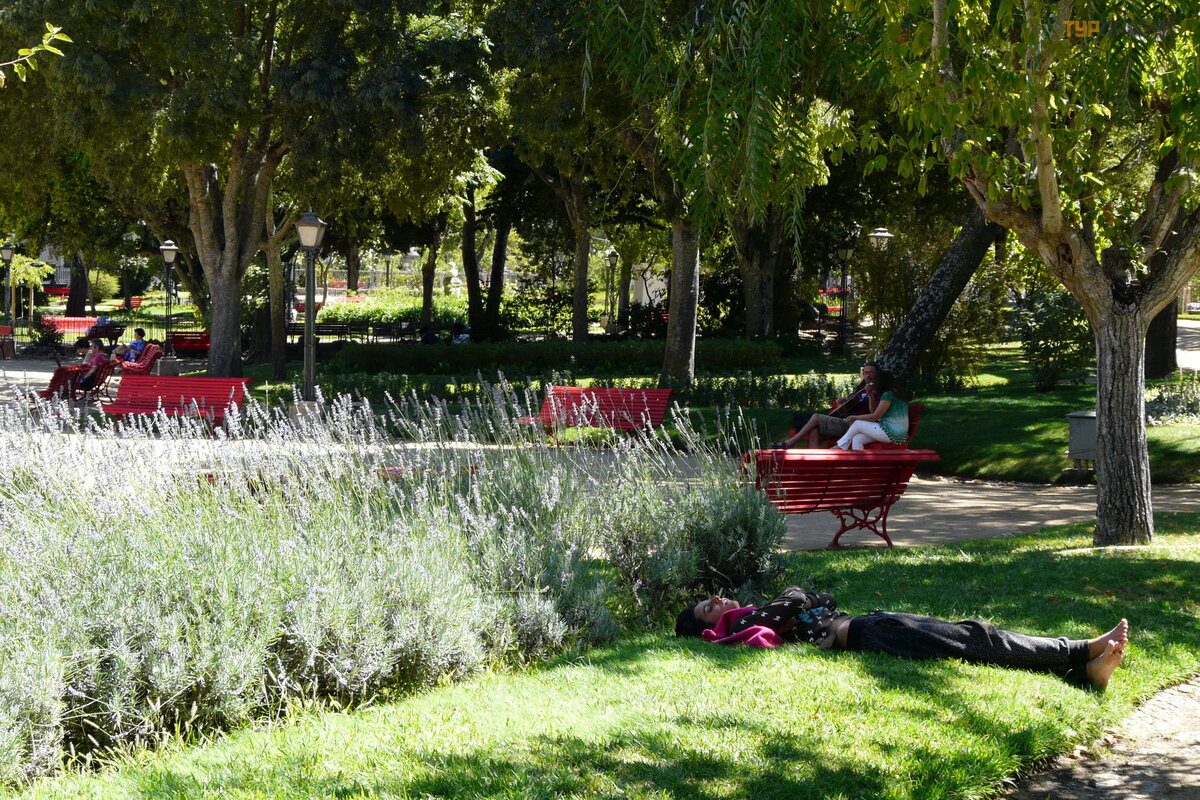 Эвора. Городской парк
Эвора. Городской парк
 Эвора. Городской парк
Эвора. Городской парк
 Эвора. Городской парк
Эвора. Городской парк
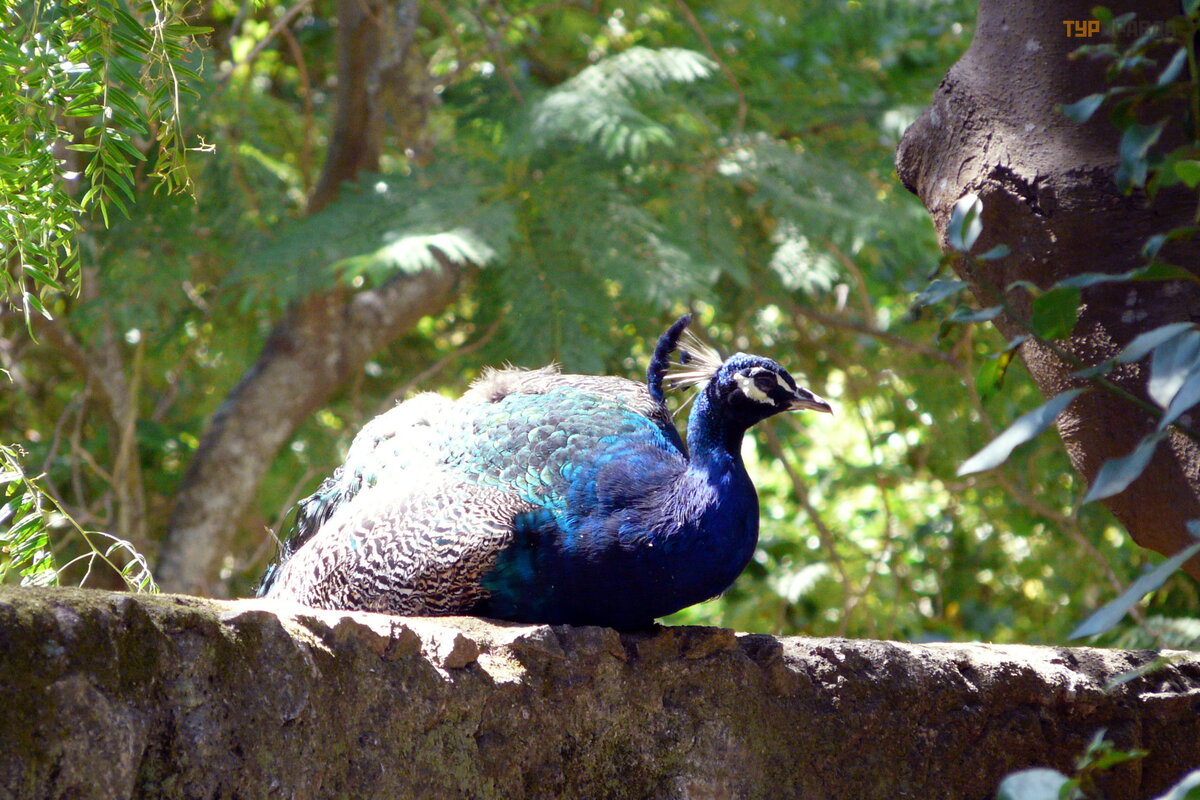 Эвора. Городской парк
Эвора. Городской парк
Иногда мне казалось, что павлины в Португалии все равно что вороны у нас в Украине. : ) Мы встречали их и в парке Замка Святого Георгия в Лиссабоне, и в Ботаническом саду у Дворца Ажуда, и вот теперь в Эворе.
Рядом с парком чуть выше по улице находится церковь Сан-Франсишку (Igreja de Sã o Francisco), готический собор, возведенный во времена правления Мануэля I приблизительно в 1510 году.
Внутри вся церковь была в лесах, и увидеть ее потрясающее убранство, о котором я читала: « интерьер поражает красотой и разнообразием отделки – здесь используется и камень, и резное дерево, и изразцы. Алтари украшают скульптуры и картины, в том числе и фламандских мастеров» , к сожалению, не получилось. В открытом доступе была лишь одна стена.
 Эвора. Церковь Сан-Франсишку
Эвора. Церковь Сан-Франсишку
 Эвора. Церковь Сан-Франсишку
Эвора. Церковь Сан-Франсишку
Поэтому нашла в интернете чужие снимки:
 Эвора. Церковь Сан-Франсишку
Эвора. Церковь Сан-Франсишку


Из собора можно пройти в знаменитую Капеллу-душ-Осуш (Capela dos Ossos) – Часовню костей.
Все стены и колонны внутри капеллы выложены человеческими костями и черепами – останками 5 000 тысяч погребенных граждан города. Надпись над входом в капеллу гласит NOS OSSOS QVE AQVI ESTAMOS PELOS VOSSOS ESPERAMOS – « Мы кости, лежащие здесь, ждем вас» . Гостеприимненько так…
История создания часовни достаточно незатейлива – войны, чума, холера и другие напасти. Небольшое местное кладбище не могло вместить всех, и, при повторных захоронениях, монахи-францисканцы выкапывали предыдущие скелеты и складировали их в церковном подвале. Ну а когда подвал переполнился, решили использовать их для строительства часовни – как символа неизбежности смерти.
 Эвора. Капелла-душ-Осуш
Эвора. Капелла-душ-Осуш
 Эвора. Капелла-душ-Осуш
Эвора. Капелла-душ-Осуш
 Эвора. Капелла-душ-Осуш
Эвора. Капелла-душ-Осуш
 Эвора. Капелла-душ-Осуш
Эвора. Капелла-душ-Осуш
 Эвора. Капелла-душ-Осуш
Эвора. Капелла-душ-Осуш
 Эвора. Капелла-душ-Осуш
Эвора. Капелла-душ-Осуш
Поднимаемся по той же улице немного вверх. Поворачиваем в улочки...
 Эвора.
Эвора.
Попадаем на небольшую площадь с еще одним собором. Это монастырь Носса-Сеньора-да-Граса (Convento de Nossa Senhora da Graca). Фасад храма притягивает внимание своим необычным оформлением – по углам фронтона расположены скульптурные глобусы, а под ними – четыре фигуры с факелами. Среди местных жителей эти фигуры прозвали « Сыны Граса» .
 Эвора. Монастырь Носса-Сеньора-да-Граса
Эвора. Монастырь Носса-Сеньора-да-Граса
В Эвору мы приехали в воскресенье. Не считая немногочисленных туристов, встречающихся у исторических памятников, на улицах было пустынно. Казалось, что горд вымер.
Спасаясь от палящего солнца, ныряем под аркаду вдоль домов и выходим на центральную площадь города Праса-ду-Жиральдо (Praç a do Giraldo).
 Эвора.
Эвора.
 Эвора. Праса-ду-Жиральдо
Эвора. Праса-ду-Жиральдо
Когда-то, во времена Средневековья, эта площадь была местом исполнения приговоров инквизиции и свидетелем множества жестоких казней. Праса-ду-Жиральдо сохранилась до наших дней в своем первозданном виде, только теперь она окружена многочисленными кафе и магазинами. А посредине площади – мраморный фонтан XVI века с восемью струями воды, символизирующими восемь улиц, ведущих на площадь, и бронзовой короной на верхушке.
У одной стороны площади находится церковь Санту-Антан (Igreja de Santo Antao), построенная в XVI веке, а с другой стороны – здание банка Португалии.
 Эвора. Церковь Санту-Антан
Эвора. Церковь Санту-Антан
Церковь Санту-Антан в Эворе возвели по высочайшему указу архиепископа города Энрике Португальского в 1557 году, который впоследствии стал королем Генрихом Португальским.
Церковь находится на месте, где до этого стояла средневековая часовня, от которой остался мраморный алтарь. Второй достопримечательностью интерьера церкви называют знаменитую картину « Души» , выполненную из изразцов.
Мы зашли в Санту-Антан, посетителей там не было, и только я собралась фотографировать, как мой взгляд упал на наклеенную на колонне бумажку с предупреждением о том, что фото- и видеосъемка в соборе платная. И в ту же минуту к нам подошла служительница храма и начала что-то говорить, требовать и показывать на дверь. Пришлось быстро ретироваться – как оказалось, собор открыт для посещения в определенное время, которое уже закончилось. Церковь очень красивая, но увы, мы не успели ее рассмотреть. : (
Поэтому фото из тырнета.



Самой известной достопримечательностью Эворы называют храм Дианы, а точнее, останки храма – единственного сохранившегося на территории Португалии памятника римского господства. Хотя его и называют храмом Дианы, никакого отношения к римской богине охоты он не имел. Это имя храм получил намного позднее из легенд семнадцатого века. Наиболее вероятно, храм возвели в честь императора Августа, которого почитали как божество и во время его правления и после смерти.
 Эвора. Храм Дианы.
Эвора. Храм Дианы.
 Эвора. Храм Дианы. Слева фасад монастыря Конвенту-душ-Лойош, справа - купол Кафедрального собора Се
Эвора. Храм Дианы. Слева фасад монастыря Конвенту-душ-Лойош, справа - купол Кафедрального собора Се
На той же площади, где расположен храм Дианы, находится здание позднеготического монастыря Конвенту-душ-Лойош (Convento dos Ló ios). Монастырь Ló ios, также известный как монастырь Святого Иоанна Богослова, был построен в XV веке на остатках средневекового замка. Во время землетрясения 1755 года монастырь сильно пострадал, и теперь, после реставрационно-восстановительных работ, здесь располагается роскошный отель.
Гуляя вокруг останков римского храма и рассматривая окружающую архитектуру, я обратила внимание на фасад этого здания и попыталась заглянуть внутрь. Сразу за дверью находилось что-то наподобие кассы, а далее все было скрыто от любопытных глаз красными бархатными шторами. Платить за осмотр чего-то неизвестного, а на карте здание обозначено как Pousada dos Ló ios, т. е. , отель, мне не очень-то хотелось. Сейчас, собираясь написать этот рассказ, я случайно нашла в интернете фотографии декора внутри монастырской церкви и очень пожалела, что не знала о ней год назад.
И опять чужие фото из интернета:



Рядом с храмом Дианы находится самый большой собор Португалии времен средневековья – Собор Успения пресвятой Богородицы или Кафедральный собор Се. Возведенный в ХII– ХIII веках на самой высокой точке города, похожий на крепость, он считается одним из самых красивых соборов: портал украшен статуями апостолов, внутри роскошный главный алтарь из розового, черного и белого мрамора.
 Эвора. Кафедральный собор Се
Эвора. Кафедральный собор Се
 Эвора. Кафедральный собор Се
Эвора. Кафедральный собор Се
 Эвора. Кафедральный собор Се
Эвора. Кафедральный собор Се
 Эвора. Кафедральный собор Се
Эвора. Кафедральный собор Се
 Эвора. Кафедральный собор Се
Эвора. Кафедральный собор Се
 Эвора. Кафедральный собор Се
Эвора. Кафедральный собор Се
 Эвора. Кафедральный собор Се
Эвора. Кафедральный собор Се
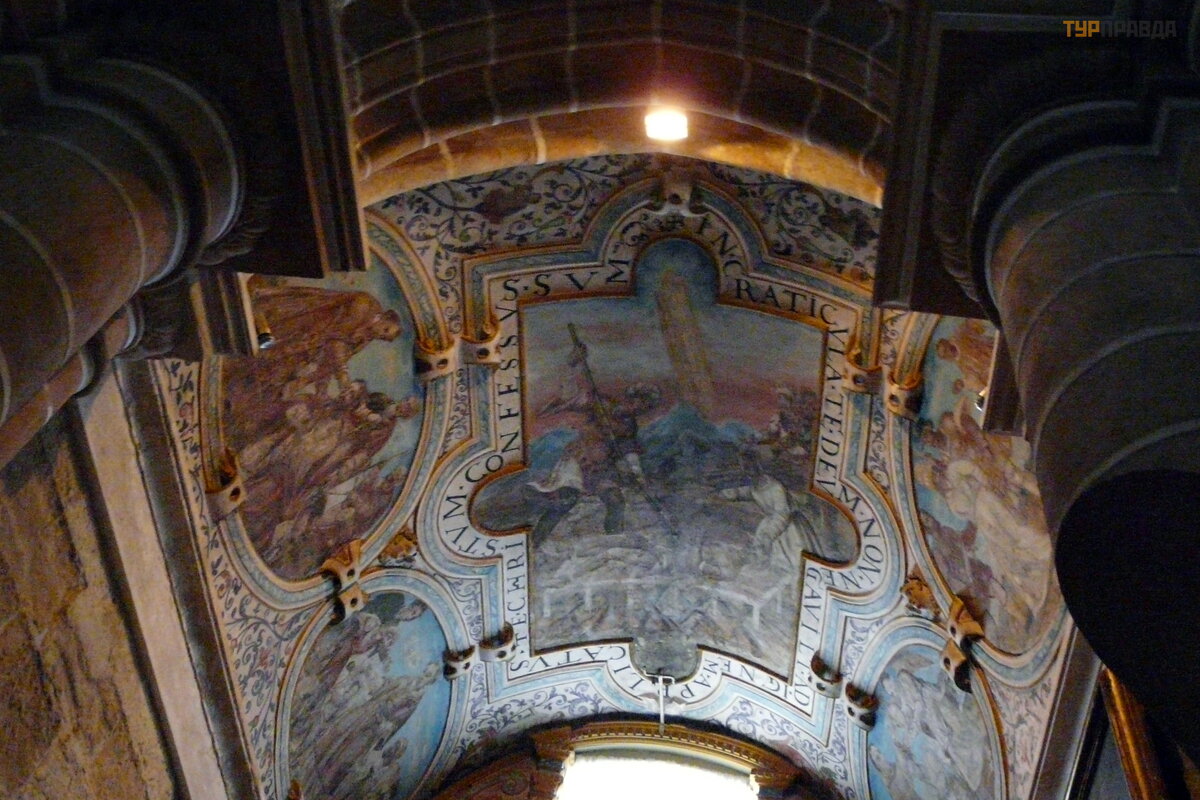 Эвора. Кафедральный собор Се
Эвора. Кафедральный собор Се
Здесь находится старейший в Португалии действующий орган XVI века. А в одной из башен разместился Музей религиозного искусства с коллекцией церковных предметов и утвари, предметов сакрального искусства, коллекцией церковных облачений.
Согласно местной легенде, именно в этом соборе были освящены флаги каравелл Васко да Гама перед отплытием в 1497 году в Индию.
 Эвора. Кафедральный собор Се
Эвора. Кафедральный собор Се
 Эвора. Кафедральный собор Се
Эвора. Кафедральный собор Се
А самое интересное и неожиданное украшение собора – статуя беременной Девы Марии, известной как Царицы Небесной Матерей. Эта статуя долго вызывала споры своим « интересным положением» , но в итоге все же была признана церковью.
 Эвора. Кафедральный собор Се
Эвора. Кафедральный собор Се
Планируя посетить Эвору, я распечатала гугловскую карту с историческим центром города, отметив на ней все интересные объекты. Я не замечала за собой проблем с ориентированием, но с этой картой, разыскивая храм Дианы, мы умудрились заблудиться, и забрели совсем в другую часть города. То ли что-то с проекцией, то ли с масштабом у этих google maps, но я уже пару раз так « забредала» . : )
Как оказалось, от центральной площади Праса-ду-Жиральдо к собору Се поднимается практически прямая небольшая улица с многочисленными сувенирными лавками и кафе. Изделия из пробкового дерева – от подставок под чашку до изящных сумочек, разноцветная керамика – традиционная посуда с яркими орнаментами, копии португальской и мавританской плитки, оригинальные дизайнерские изделия, изделия из текстиля. Ну и, конечно, местные вина – из провинции Алентежу, считающиеся одними из лучших в Португалии.
Оторвавшись от своей компании, я бродила узкими улочками Эворы, наслаждаясь их тишиной, любовалась белыми с желтой окантовкой домами, кое-где встроенными в арки акведука – еще одного памятника, оставшегося от древних римлян, рассматривала витрины многочисленных магазинов, слушала звуки города и фотографировала, фотографировала, фотографировала…
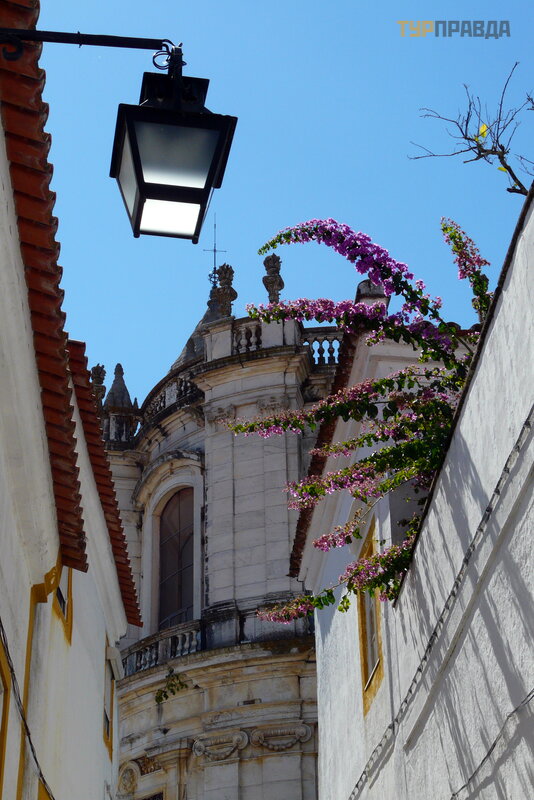 Эвора.
Эвора.
 Эвора.
Эвора.
 Эвора.
Эвора.
 Эвора.
Эвора.
 Эвора.
Эвора.
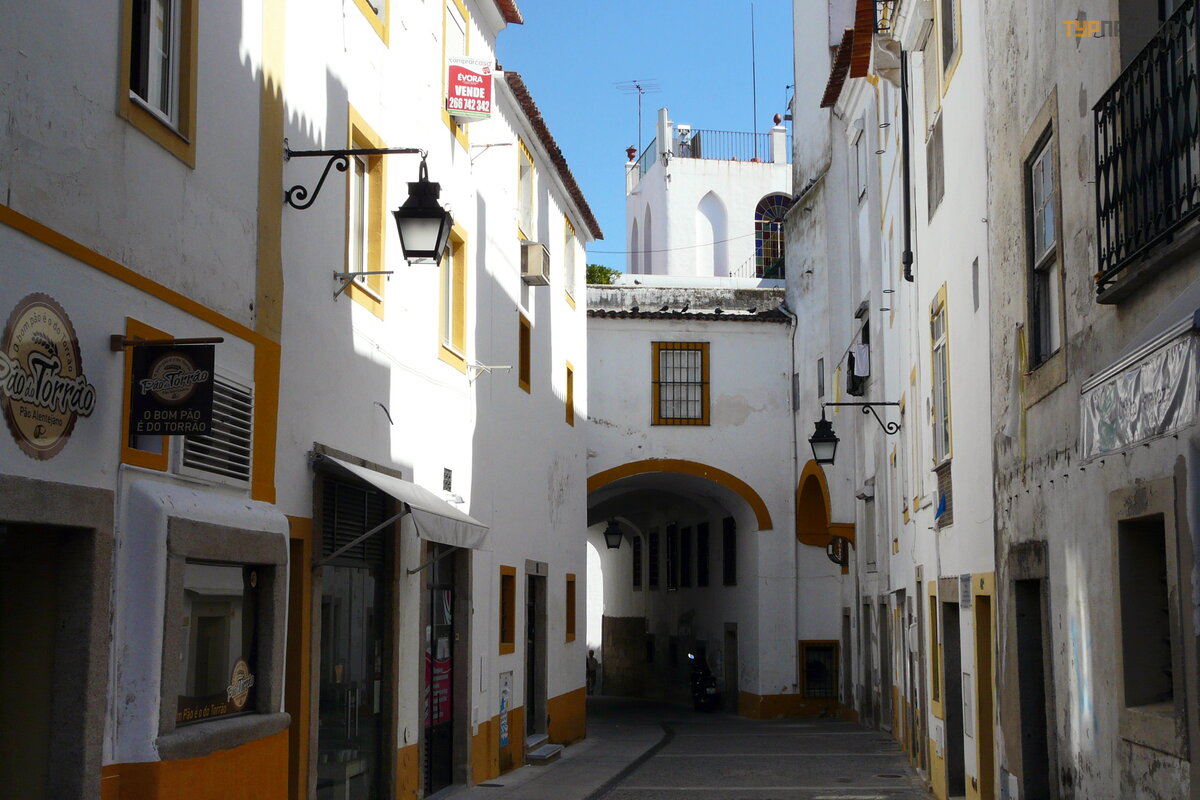 Эвора.
Эвора.
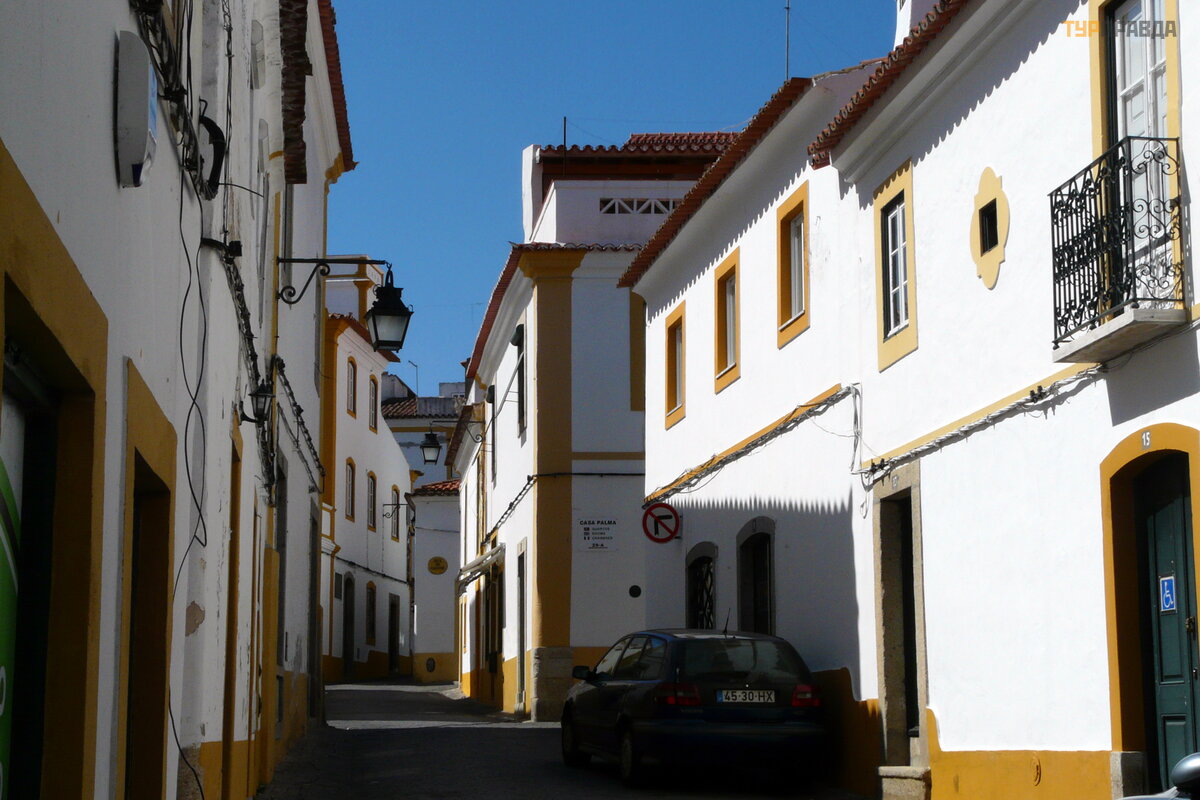 Эвора.
Эвора.
 Эвора.
Эвора.
 Эвора.
Эвора.
 Эвора.
Эвора.
 Эвора.
Эвора.
Эвора сумела достучаться до моего сердца и очаровать своей простотой и гармонией.
“My white city - you are a flower made of stone, washed by good sunny rain. . . ” - Sofia Rotaru once sang about Chisinau. These words can be fully pronounced in the address of many Portuguese cities. I would like to tell you about Evora - the heart of the Portuguese province of Alentejo.
Fortified castles scattered over the hills, small medieval towns with white houses, surrounded by vineyards, olive tree plantations and cork oak groves - all this is Alentejo, the largest region located in the center of Portugal.
Evora, the largest and most beautiful city in the province, with a rich cultural and historical past, was an important center for the Romans, the Moors, became the residence of episcopals, and later the residence of the Portuguese kings, was a witness to many royal weddings.
Here, the labyrinths of narrow medieval streets are intertwined with sun-drenched squares, Gothic portals, Moorish courtyards, monasteries, cathedrals, palaces. . . The historic center of the city is included in the UNESCO World Heritage List.
For many centuries Evora has been the spiritual center of the country - for 41 thousand citizens there are almost 30 churches and monasteries.
On one of the days of our acquaintance with Portugal, we went to É vora by train from Lisbon's Entrecampos station. The city greeted us with dry hot air and traditionally decorated with tiles - azulejos - the station building.
 Evora. Station
Evora. Station
 Evora. Station
Evora. Station
The first building on the way from the station to the center of É vora, which attracted our attention, looks like either a castle or a fortress - the San Bras Chapel (Ermida de Sã o Bras). This temple was erected on the initiative of King John II and Bishop of É vora D. Garcia de Menezes in 1483 in the style of the "Gothic version of Manueline-Mudé jar". As it turned out, the walls topped with battlements and conical turrets are typical of the Alentejo.
 Evora. Chapel of San Bras
Evora. Chapel of San Bras
 Evora. Chapel of San Bras
Evora. Chapel of San Bras
When we approached the entrance to the chapel, the morning service was taking place, and several people were standing on the street - the hall is small inside. But as soon as I picked up the camera, people politely parted, allowing me to take a picture.
 Evora. Chapel of San Bras
Evora. Chapel of San Bras
 Evora. Chapel of San Bras
Evora. Chapel of San Bras
And then, passing through a deserted (not counting the monument in the middle) and open to the scorching sun square, we ended up in the City Park (Jardim Pú blico).
When I studied the map of É vora while preparing for my trip to Portugal, I marked this park on the map - “it would be nice to visit it in the end”. But it turned out that it was with him that we began our acquaintance with the city.
The park was laid out on the site of an ancient palace in the XIV century Palacio de Dom Manuel (Palacio de Dom Manuel). At first, the palace served as the residence of King Afonso V, then to Kings Joao II and Manuel I. Prince Afonso and Princess Isabella were married here.
 Evora. Palacio de Dom Manuel
Evora. Palacio de Dom Manuel
 Evora. Palacio de Dom Manuel
Evora. Palacio de Dom Manuel
 Evora. Palacio de Dom Manuel
Evora. Palacio de Dom Manuel
Unfortunately, only some of the authentic elements of the palace have survived to this day, namely the Gallery of the Lady (Galeria das Damas). There is an assumption that it was in this gallery that King Manuel I appointed Vasco da Gama as commander of the Indian fleet.
Now various art exhibitions and cultural events are held here.
Walking around the palace, you come across the ruins of the castle. Unfortunately, they turned out to be fake. But what do they look like! : )
 Evora. City Park
Evora. City Park
 Evora. City Park
Evora. City Park
 Evora. City Park
Evora. City Park
There are many cafes in the park where you can sit at a table on the terrace and watch the ducks swimming in the pond. There is a fountain in the central square of the park. It is believed that if you throw a few coins into the water, then your wish will certainly come true.
A pond with a bridge and floating ducks - I remember, but I did not pay attention to the fountain. But the scarlet benches along the paths simply enchanted with their color! : )) And also - peacocks. Lots of peacocks.
 Evora. City Park
Evora. City Park
 Evora. City Park
Evora. City Park
 Evora. City Park
Evora. City Park
 Evora. City Park
Evora. City Park
 Evora. City Park
Evora. City Park
Sometimes it seemed to me that peacocks in Portugal are like crows in Ukraine. : ) We met them in the park of the Castle of St. George in Lisbon, and in the Botanical Garden near the Ajuda Palace, and now in Evora.
Near the park just up the street is the Church of Sã o Francisco (Igreja de Sã o Francisco), a Gothic cathedral built during the reign of Manuel I around 1510.
Inside, the whole church was in the woods, and to see its stunning decoration, which I read about: “the interior is striking in its beauty and variety of decoration - stone, carved wood, and tiles are used here. The altars are decorated with sculptures and paintings, including those by Flemish masters”, unfortunately, it did not work out. Only one wall was open to the public.
 Evora. Church of San Francisco
Evora. Church of San Francisco
 Evora. Church of San Francisco
Evora. Church of San Francisco
That's why I found other people's pictures on the Internet:
 Evora. Church of San Francisco
Evora. Church of San Francisco


From the cathedral you can go to the famous Capela dos Ossos - the Chapel of Bones.
All the walls and columns inside the chapel are lined with human bones and skulls - the remains of 5.000 thousand buried citizens of the city. The inscription above the entrance to the chapel reads NOS OSSOS QVE AQVI ESTAMOS PELOS VOSSOS ESPERAMOS - "We are the bones lying here waiting for you. " So hospitable…
The history of the creation of the chapel is quite simple - wars, plague, cholera and other misfortunes. The small local cemetery could not accommodate everyone, and in case of repeated burials, the Franciscan friars dug up the previous skeletons and stored them in the church cellar. Well, when the basement overflowed, they decided to use them to build a chapel - as a symbol of the inevitability of death.
 Evora. Chapel-dos-Osush
Evora. Chapel-dos-Osush
 Evora. Chapel-dos-Osush
Evora. Chapel-dos-Osush
 Evora. Chapel-dos-Osush
Evora. Chapel-dos-Osush
 Evora. Chapel-dos-Osush
Evora. Chapel-dos-Osush
 Evora. Chapel-dos-Osush
Evora. Chapel-dos-Osush
 Evora. Chapel-dos-Osush
Evora. Chapel-dos-Osush
Let's go up the same street a little. Turning into the streets. . .
 Evora.
Evora.
We get to a small square with another cathedral. This is the monastery of Nossa Senhora da Graca (Convento de Nossa Senhora da Graca). The facade of the temple attracts attention with its unusual design - at the corners of the pediment there are sculptural globes, and under them - four figures with torches. Among the locals, these figures were nicknamed "Sons of Grasse".
 Evora. Monastery of Nossa Senhora da Graç a
Evora. Monastery of Nossa Senhora da Graç a
We arrived in Evora on Sunday. Apart from the few tourists who meet at historical monuments, the streets were deserted. It seemed that pride had died out.
Fleeing from the scorching sun, we dive under the arcade along the houses and go out to the central square of Praç a do Giraldo.
 Evora.
Evora.
 Evora. Praç a do Giraldo
Evora. Praç a do Giraldo
Once, during the Middle Ages, this square was the site of the execution of the Inquisition and a witness to many cruel executions. Praç a do Giraldo has survived to this day in its original form, only now it is surrounded by numerous cafes and shops. And in the middle of the square there is a marble fountain of the 16th century with eight jets of water, symbolizing the eight streets leading to the square, and a bronze crown on top.
On one side of the square is the Church of Santo Antao (Igreja de Santo Antao), built in the 16th century, and on the other side is the building of the Bank of Portugal.
 Evora. Church of Santo Antan
Evora. Church of Santo Antan
The Church of Santo Antan in Evora was erected by the highest decree of the archbishop of the city Enrique of Portugal in 1557, who later became King Henry of Portugal.
The church is located on the site where before that there was a medieval chapel, from which a marble altar remained. The second attraction of the interior of the church is the famous painting "Souls", made of tiles.
We entered Santo Antan, there were no visitors, and just as I was about to take pictures, my eyes fell on a piece of paper pasted on a column with a warning that photography and video filming in the cathedral was paid. And at the same moment a servant of the temple came up to us and began to say something, demand and point to the door. I had to quickly retreat - as it turned out, the cathedral is open to the public at a certain time, which has already ended. The church is very beautiful, but alas, we did not have time to see it. : (
Therefore, the photo is from tyrnet.



The most famous landmark of É vora is called the Temple of Diana, or rather, the remains of the temple - the only monument of Roman rule that has survived in Portugal. Although it is called the temple of Diana, it had nothing to do with the Roman goddess of the hunt. The temple received this name much later from the legends of the seventeenth century. Most likely, the temple was erected in honor of the emperor Augustus, who was revered as a deity both during his reign and after his death.
 Evora. Temple of Diana.
Evora. Temple of Diana.
 Evora. Temple of Diana. On the left is the facade of the Convento dos Loios monastery, on the right is the dome of the Cathedral of Ce
Evora. Temple of Diana. On the left is the facade of the Convento dos Loios monastery, on the right is the dome of the Cathedral of Ce
In the same square where the temple of Diana is located, there is the building of the late Gothic monastery of Convento dos Loios (Convento dos Ló ios). The monastery of Ló ios, also known as the monastery of St. John the Evangelist, was built in the 15th century on the remains of a medieval castle. During the earthquake of 1755, the monastery was badly damaged, and now, after restoration and restoration work, a luxurious hotel is located here.
Walking around the remains of a Roman temple and looking at the surrounding architecture, I noticed the facade of this building and tried to look inside. Immediately outside the door was something like a cash register, and then everything was hidden from prying eyes by red velvet curtains. I didn’t really want to pay to see something unknown, and on the map the building is marked as Pousada dos Ló ios, that is, the hotel. Now, when I was about to write this story, I accidentally found photos of the decor inside the monastery church on the Internet and I really regretted that I did not know about it a year ago.
And again, other people's photos from the Internet:



Next to the temple of Diana is the largest cathedral in Portugal from the Middle Ages - the Cathedral of the Assumption of the Blessed Virgin Mary or the Cathedral of Se. Erected in the 12th-13th centuries on the highest point of the city, it looks like a fortress, it is considered one of the most beautiful cathedrals: the portal is decorated with statues of the apostles, inside there is a luxurious main altar made of pink, black and white marble.
 Evora. Se Cathedral
Evora. Se Cathedral
 Evora. Se Cathedral
Evora. Se Cathedral
 Evora. Se Cathedral
Evora. Se Cathedral
 Evora. Se Cathedral
Evora. Se Cathedral
 Evora. Se Cathedral
Evora. Se Cathedral
 Evora. Se Cathedral
Evora. Se Cathedral
 Evora. Se Cathedral
Evora. Se Cathedral
 Evora. Se Cathedral
Evora. Se Cathedral
Here is the oldest functioning organ in Portugal from the 16th century. And in one of the towers there is the Museum of Religious Art with a collection of church objects and utensils, sacred art objects, a collection of church vestments.
According to local legend, it was in this cathedral that the flags of Vasco da Gama's caravels were consecrated before sailing to India in 1497.
 Evora. Se Cathedral
Evora. Se Cathedral
 Evora. Se Cathedral
Evora. Se Cathedral
And the most interesting and unexpected decoration of the cathedral is the statue of the pregnant Virgin Mary, known as the Queen of Heavenly Mothers. This statue caused controversy for a long time with its "interesting position", but in the end it was nevertheless recognized by the church.
 Evora. Se Cathedral
Evora. Se Cathedral
Planning to visit Evora, I printed out a Google map with the historical center of the city, marking all the interesting objects on it. I did not notice any problems with orientation, but with this map, looking for the temple of Diana, we managed to get lost and wandered into a completely different part of the city. Either something with the projection, or with the scale of these google maps, but I already “wandered” like that a couple of times. : )
As it turned out, an almost straight small street with numerous souvenir shops and cafes rises from the central Praç a do Giraldo to the Se Cathedral. Products made of cork wood - from cup coasters to elegant handbags, multi-colored ceramics - traditional dishes with bright ornaments, copies of Portuguese and Moorish tiles, original designer products, textile products. And, of course, local wines - from the province of Alentejo, considered one of the best in Portugal.
Tearing off from my company, I wandered the narrow streets of Evora, enjoying their silence, admiring the white houses with yellow edging, in some places built into the arches of the aqueduct - another monument left over from the ancient Romans, looking at the windows of numerous shops, listening to the sounds of the city and photographed, photographed, photographed...
 Evora.
Evora.
 Evora.
Evora.
 Evora.
Evora.
 Evora.
Evora.
 Evora.
Evora.
 Evora.
Evora.
 Evora.
Evora.
 Evora.
Evora.
 Evora.
Evora.
 Evora.
Evora.
 Evora.
Evora.
Evora managed to get through to my heart and charm with her simplicity and harmony.
 Evora. Church of San Francisco
Evora. Church of San Francisco Evora. Church of San Francisco
Evora. Church of San Francisco Evora. Church of San Francisco
Evora. Church of San Francisco
 Evora. Monastery of Nossa Senhora da Graç a
Evora. Monastery of Nossa Senhora da Graç a


 Evora. Temple of Diana. On the left is the facade of the Convento dos Loios monastery, on the right is the dome of the Cathedral of Ce
Evora. Temple of Diana. On the left is the facade of the Convento dos Loios monastery, on the right is the dome of the Cathedral of Ce














































































































